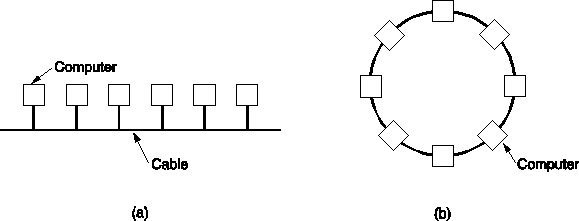|
|
|
|
There is no generally accepted taxonomy into which all computer networks fit, but two dimensions stand out as important: transmission technology and scale.
Classification of networks according to transmission technology:
Broadcast networks are networks with single communication channel shared by all the machines. Short messages (packets) sent by any machine are received by all others. An address field within the packet specifies for whom it is intended. Analogy: someone shout in the corridor with many rooms.
Broadcasting is a mode of operation in which a packet is sent to every machine using a special code in the address field.
Multicasting is sending a packet to a subset of the machines.
Point-to-point networks consist of many connections between individual pairs of machines. In these types of networks:
General rule (with many exceptions): smaller, geographically localized networks tends to use broadcasting, larger networks usually are point-to-point.
Classification of networks by scale: If we take as a criterion the interprocessor
distance, we get on the one side of the scale data flow machines, highly parallel
computers with many functional units all working on the same program. Next come
the multicomputers, systems that communicate through short, very fast buses.
Beyond the multicomputers are the true networks, computers communicating over
longer cables. Finally, the connection of two or more networks is called an
internetwork. Distance is important as a classification metric because different
techniques are used at different scales.
1.2.1. Local Area Networks
Local area networks (LANs) re privately-owned, within a single building or campus, of up to a few kilometers in size. They are distinguished from other kind of networks by three characteristics:
LANs are restricted in size - the worst-case transmission time is known in advance, it makes possible to use certain kinds of design.
LANs transmission technology often consists of a single cable to which all machines are attached. Traditional LANs run at speed of 10 to 100 Mbps. Newer LANs may operate at higher speeds.
Possible topologies for broadcast LANs (Fig. 1-3):

Fig. 1-3. Two broadcast networks. (a) Bus. (b) Ring.
Broadcast networks can be, depending on how the channel is allocated, further divided into:
LAN built using point-to-point lines is really a miniature WAN.
1.2.2. Metropolitan Area Networks
Metropolitan area network (MAN) is basically a bigger version of a LAN and normally
uses similar technology. It might cover a group of nearby corporate offices or a
city and might be either private or public. The main reason for even distinguishing
MANs as a special category is that a standard has been adopted for them.
It is called DQDB (Distributed Queue Dual Bus).
1.2.3. Wide Area Networks
A wide area network (WAN):
The subnet usually consists of transmission lines (circuits, channels, or trunks) and switching elements. The switching elements are specialized computers used to connect two or more transmission lines. There is no standard technology used to name switching elements (e.g. packet switching nodes, intermediate systems, data switching exchanges). As a generic term we will use the word router. (Fig. 1-5)

Fig. 1-5. Relation between hosts and the subnet.
Remark: the term "subnet" also acquired a second meaning in conjuction with network addressing.
If two routers that do not share a cable wish to communicate, they must do it via other routers. When a packet is sent from one router to another via intermediate routers, the packet is received at each intermediate router, stored there until the required output line is free, and then forwarded. A subnet using this principle is called point-to-point, store-and-forward, or packet-switched subnet. Nearly all wide area networks (except those using satellites) have store-and-forward subnets.
When the packets are small and all the same size, they are often called cells.
A second possibility for a WAN is a satellite or ground radio system. Each
router has an antenna through which it can send and receive. All router can hear
the output from the satellite. Satellite networks are inherently broadcast.
1.2.4. Wireless Networks
The owners of mobile computers want to be connected to their home base when they are away from home. In case where wired connection is impossible (in cars, airplanes), the wireless networks are necessary.
The use of wireless networks:
Wireless networking and mobile computing are often related but they are not identical. Portable computers are sometimes wired (e.g. at the traveler's stay in a hotel) and some wireless computer are not portable (e.g. in the old building without any network infrastructure).
Wireless LANs are easy to install but they have also some disadvantages: lower capacity (1-2 Mbps, higher error rate, possible interference of the transmissions from different computers).
Wireless networks come in many forms:
Internetwork or internet is a collection of interconnected networks. A common form of internet is a collection of LAN connected by WAN. Connecting incompatible networks together requires using machines called gateways to provide the necessary translation.
Internet (with uppercase I) means a specific worldwide internet.
Subnets, networks and internetworks are often confused.
Subnet makes the most sense in the context of a wide area network, where it refers to the collection of routers and communication lines. The combination of a subnet and its hosts forms a network. An internetwork is formed when distinct networks are connected together.